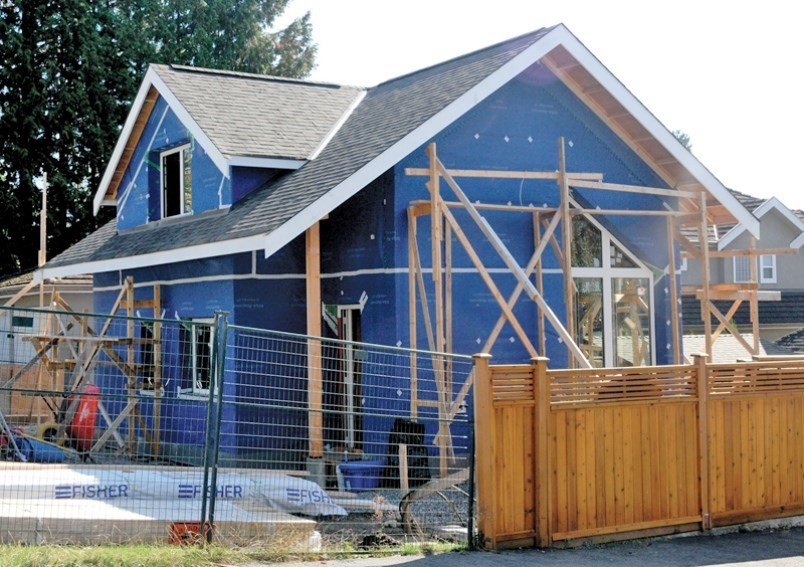If the pace of development is a nail, it may be time for District of North Vancouver council to swing the hammer.
That was the message from Mayor Mike Little during a wide-ranging council discussion on development, infrastructure and quality of life on Jan. 14.
“Our focus should be on the pace of approvals,” Little said. “That’s where we have the hammer.”
Approximately two months after a majority of council rejected townhouses at Ridgewood Drive and below-market rentals at Delbrook, Coun. Mathew Bond questioned the efficacy of aiding quality of life while focusing on “one piece of the puzzle.”
Despite lagging behind regional growth rates, the district has needed to build more to support its increasingly diffuse population, Bond said. There were 2.7 people in an average district household in 2016 – a drop from 2.9 in 1996.
While Bond acknowledged the district’s ubiquitous construction zones, he pointed out that in 2018 there were 666 single-family homes being built or undergoing major renovations. Comparatively, there have been an average of 595 units of multi-family housing under construction each year since 2011.
“If we’re worried about construction traffic . . . then we need to really focus on multi-family approvals and single-family construction at least equally,” he said.
Eight years of unaffordable development has resulted in an increasingly unlivable community, countered Coun. Lisa Muri.
Housing every would-be resident while maintaining the municipality’s appeal is an impossibility, she explained.
“We can’t build a unit for every person that wants to come and live in this community; and if we did that we wouldn’t want to live in this community,” she said.
Bond differed.
“If this community takes the approach that we can’t necessarily build a home for everyone that wants to live here, the market will sort who gets to live here; and ... only the wealthiest, highest income earners will be able to live here.”
The district’s population ballooned by more than 33,000 between 1951 and 1966. Following that boom period, the district population ticked up by an average of 1,000 residents per year until 1996, according to census data.
From 1996 until 2016, the district’s population rose by 5,517 – an average of 275.9 residents per year.
During that stretch the median age hopped from 37.5 to 44.3. The number of residents in the labour force rose by 1,065 while the number of those not in the labour force jumped by 5,855.
According to figures supplied by the province, the district’s population for 2018 was 90,814.
In projecting a district population of 104,400 by 2030, the district’s official community plan – passed in 2011 – envisioned adding 10,000 jobs to the municipality.
That OCP likely needs a review and a few tweaks, according to Coun.
Betty Forbes.
The district needs to enforce maintenance of older buildings to prevent teardowns and lost purpose-built rentals, according to Forbes.
Forbes also called on the district to prioritize non-market purpose-built social housing, which she said could likely be achieved by partnering with non-profit agencies.
Forbes also underscored the need to present a cost-benefit analysis of each potential development to the community.
“If we build social housing with our revenues, then your property taxes might go up because we have to get that revenue in order to support the infrastructure,” she said hypothetically.
The district has “failed miserably” to hit greenhouse gas emission targets, Coun. Megan Curren said, calling on council to address climate change with a wartime level of urgency.
While other communities have a SkyTrain capable of moving 4,000 commuters per hour, “We have, maybe, a new bus,” she said.
The district needs to protect purpose-built rental stock, focus on social housing, and look at jobs when considering new development, according to Curren.
While the population is only increasing by a “sliver,” Coun. Jim Hanson emphasized the impacts of that sliver.
“It is a fact that the demands on our transportation systems are getting greater at a rate that’s faster than that census increase,” he said.
The flaw of the previous councils was their tendency to approve too many market condos “and not enough of everything else,” Hanson said.
“As long as we have a single homeless person in North Vancouver District I wonder why we would be prioritizing any other category of housing,” Hanson said, calling for council to prioritize housing for seniors, people with disabilities, and people with low incomes.
The district should prioritize both market and non-market rental housing, according to Coun. Jordan Back.
In assessing long-term growth – excluding a few periods of unfettered, green field development – Little characterized the municipality’s historic population increases as modest and steady.
However, there’s something to be learned from the periods when the district vastly increased their housing stock for generation X and the baby boomer generation, according to Bond.
“Times were good, apparently, from what I’ve heard,” he said of the 1960s housing boom. But the district’s approach to housing has changed in recent years, Bond continued.
“We have not built tons of homes for people, and things have gotten bad,” he said, imploring his colleagues to consider the ramifications of inaction.
A lack of affordable housing had resulted in a generation moving away and created a “crisis point,” according to a 2018 report from the district’s OCP implementation monitoring committee.
The committee found the district’s town centre concept was sound in principal but was “failing to deliver the range of affordable options” required for families.



